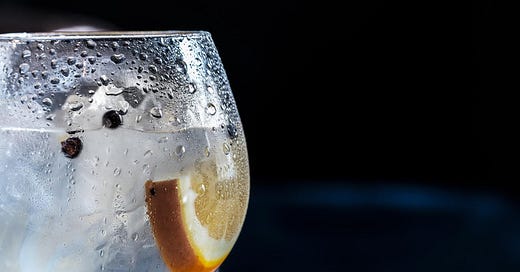Itty Bitty Inquiries is back this week after a brief holiday hiatus!
Sometimes I use a coaster when I put a drink on my fancy IKEA coffee table, and sometimes I don’t. I’d like to think that when I do use a coaster, it’s because my brain subconsciously knows that cold drinks create more condensation than those that are at room temperature. However, my coaster use is far more likely based on the coaster’s proximity. Anyway, this is my long-winded way of saying that this edition of the newsletter will focus on the process of condensation. Why and how does condensation happen?
Perhaps after writing this, I will be a bit more strategic with my coaster use.
What is condensation?
Water (or H2O) can exist in three states of matter: liquid, solid, and gas. Condensation is simply the process of transitioning water from a gaseous state to a liquid state, like reverse evaporation. The key factor in these state transitions is temperature. When water vapor (the gaseous state of H2O) reaches a certain temperature, it is converted into a liquid form. The specific temperature at which this process happens is called the dew point. That’s right, dew as in the wet grass you sometimes see in the mornings.
There is always some water vapor in the air around us. Some places have a lot of moisture in the air, such as more humid environments, and other areas, like deserts, have less. Warm air can ‘hold’ more water than cool air because the molecules in warm air are moving around at faster speeds (they have more energy). As they zoom around, they create more space for water molecules to move around at high speeds as well. The faster the water molecules are moving around, the harder it is for them to stick together. Once the air starts to cool, the air molecules (nitrogen, oxygen, etc.) start to slow down and get closer together, reducing the space available for the water molecules, which are also slowing down. The water molecules then start sticking together and condensing into liquid form…hence the name condensation.
How does condensation happen on glass or cans?
When the water vapor in the air comes into contact with a cold surface (at the dew point temperature), the water vapor condenses into liquid form on the surface. This is why your cold beer can or iced beverage will start to show water droplets. If you’re in a relatively warm environment, you can watch this process unfold in a matter of minutes. Simply fill two glasses with room temperature water and only put ice in one glass. Before long you’ll start to see moisture gathering on the ice water glass and none on the room temperature water glass. Condensation is also the reason that your windows sometimes fog up when it’s cold outside.
Another, very important, condensation process
While the occurrences of condensation I’ve described so far are interesting, and sometimes, mildly annoying, there is another way in which condensation affects us: rain! Condensation is a very important part of the natural water cycle, which keeps us and all living things on earth alive. As collections of water vapor in the sky (clouds) get denser, they eventually reach a point of saturation. This means that at a certain water vapor density, the air can no longer hold the water, causing it to condense into a liquid state and fall in the form of rain. This process is aided by the fact that the upper atmosphere is typically cooler than the lower atmosphere, so as the water vapor rises, the molecules begin to slow down and get closer together, as we discussed earlier.
Bonus condensation tip!
Researchers recently discovered that condensation plays a major role in heating up your cold beverage. Experiments showed that cold cans with condensation on the outside warm the liquid inside almost twice as quickly as those without condensation. If you’re drinking a cold soda or beer in a warm humid environment, make sure to keep the condensation off your can if you want to keep your beverage chilly!
Here’s more information about these findings:





As someone who's taking the last course of chemistry (I have finally made it) I found this explanation both light and thorough. Exceptional writing and amazing explanation, I'm so glad I have discovered this :)